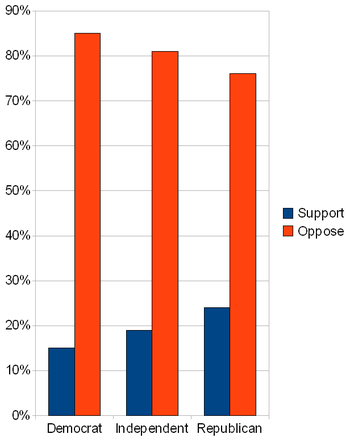Soundtrack in my head: Holly Beth Vincent, “For What It’s Worth (Stop Hey What’s That Sound)”

It turns out that this month of September will have several critical tests for democracy coming up.
The U.S. Senate will be voting on a constitutional amendment to overturning Citizens United most likely sometime this week. For the first time, every U.S. Senator will have to go on record as to whether they believe money is actually speech (meaning that those with more money have more of a voice). As can be seen from the graphic on the right, party affiliation has little bearing on the public’s stance on Citizens United–the public overwhelmingly disagrees with the Supreme Court’s ruling on the case. But that hasn’t stopped special interests from dominating our government.
Another test for democracy comes next week on 15 September, the comment period for the Federal Communications Commission’s (FCC) proposal to allow big telecom companies to turn the Internet into a pay-to-play scheme. In this proposal, anyone who pays enough money can have their sites more accessible while the rest of us are relegated to an Internet “slow lane.” Since the mid 2000s, AT&T, Verizon, Comcast and other big players have resisted every effort to make “net neutrality” the law of the land. But more recently, in rather Orwellian language, they have argued that setting up a two-tier Internet somehow actually protects Net Neutrality. I think a lot of start-up businesses, small businesses and other independent producers of content would firmly disagree. This Wednesday 10 September has been designated “Internet Slowdown Day” in which a number of websites, including Reddit, Vimeo, WordPress, Meetup and this website will demonstrate the impact of an Internet slow lane in a very, well, graphic way.

Finally, on 18 September, citizens of Scotland will vote to decide whether they will remain part of the United Kingdom or become an independent country. Ethnically, I am about half-Scottish from both sides of my family and descended from multiple Scottish families. Recently, polls show a dead heat for the referendum. While my heart is for Scottish independence, this is the decision for the Scottish themselves to make, and I am reluctant to weigh in. But my observation is that a smaller, more localized government can be held more easily accountable by its citizens than a larger, more distant government. Not always, of course (especially in places that have ethnic and racial minorities), but I have very much noticed the difference between living in Chicago and Madison, and I find the government in Madison much more accessible and democratic. Furthermore, government surveillance in the United Kingdom is as worrisome as that in the United States
I find this interesting because besides being about half Scottish, I am also one-fourth Lithuanian and Hungarian. (I reportedly also have smaller bits of German, English, Irish, Dutch and Slovak ancestry as well, and perhaps even Native American). With my ancestors primarily coming from Scotland, Hungary and Lithuania, I find it noteworthy that of these three ancestries, only one of them–Hungary–was an independent country when I was born, and its independence was somewhat questionable given that the Soviet Union intervened to overthrow the Hungarian government in 1956 after it promised reform after an uprising. But Hungary won its independence from the Soviet bloc in 1989 and Lithuania declared independence in 1990. Might Scotland be next?

